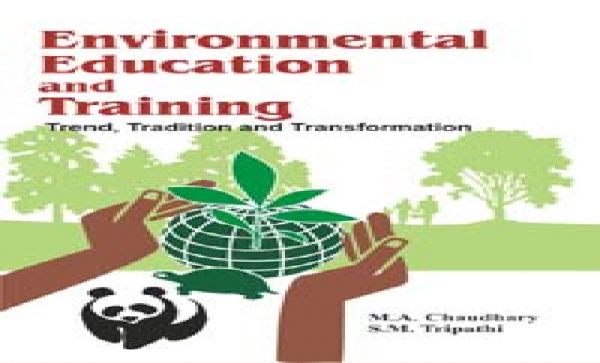NON-FORMAL ENVIRONMENTAL EDUCATIONAL

Activities exist alongside the formal educational systems, at curricular and extracurricular levels, in occupational training, and through wide public awareness activities through non-formal channels such as mass media, and voluntary organizations. Different communities, institutions and individuals choose methods and practices that best suit their local needs and capacities.
Learning by Doing
In several countries, there are efforts to get students to relate to local problems, while understanding their global implications. In Bangladesh, an environmental education programme called Muktangan Siksha, or open-air education, encourages field programmes related to the surroundings and communities. In Myanmar, an imaginative pre-school and lower primary environmental programme bases its teaching on a study of the surroundings, or patwinkyin, without formal textbooks. In Sri Lanka, a WWF-supported innovative environmental education programme involving over 750 schools has been implementing an approach called ‘greening of learning’. In this, students are encouraged to beautify the school garden, start a plant nursery or engage in other ‘green’ activities within the school premises. Due to its success the WWF has started introducing the same concepts and approaches in other countries, such as Viet Nam.
Research and advocacy organizations are increasingly involved in developing non-formal environmental activities. For example, Development Alternatives (DA) located in India, has launched the Community Led Environmental Action Network (CLEAN) which promotes among school children and community’s activities based on the “four r” concept: refuse, reduce, recycle and reuse. In several countries, government agencies or NGOs support nature clubs or environmental societies in schools as a means of encouraging and inspiring students to undertake non-formal environmental activities.
Outdoor Activities
Government agencies as well as NGOs have developed a wide array of outdoor activities that expose youth and adults to different aspects of environmental awareness, action and understanding. For example, in Nepal, Environmental Camps for Conservation Awareness (ECCA), a local NGO, has been active for over a decade in organising outdoor environmental activities aimed at children, both able and disabled. These camps are held at places of environmental significance and aim to raise awareness about conservation issues, and to potential careers in conservation.
Similar environmental camps have become a regular feature in many countries. For example, in Malaysia, environmental awareness camps are regularly organized by the Department of Environment. The camps are for children between 14 and 16 years of age, at the Nature Education Centre (NEC) established in 1992 by the Malaysian Nature Society. In Singapore, the Ministry of Environment allocates small portions of the beach to volunteering schools under an ‘Adopt a Beach’ programme. Students are then responsible for keeping that stretch of the beach clean, and in that process learn aspects of the coastal and marine environment.
The China Association for Science and Technology (CAST) is engaged in the promotion of non-formal science education for children and youth. CAST has 165 natural science societies and is established at county level all over the country. CAST relies on its member scientists and technologists to provide the knowledge base and necessary human resources for various activities organized to promote better understanding of science, technology and environmental issues. Also in People’s Republic of China, the State Environmental Protection Administration (SEPA) is playing a lead role in non-formal activities, and has introduced the Global Learning and Observations to Benefit the Environment (GLOBE) Programme, a worldwide network focusing on science and education, which brings together students, teachers and scientists in order to share information on monitoring the global environment.
Innovative Approaches
New strategies and innovations for environmental education have been developed and applied throughout the region. For example, in Singapore, the Ministry of Environment in 1996 published the ‘Fun and Discovery Through Environmental Clubs’, outlining environmental activities and clubs. Similar publications have been developed in Japan, India and Bangladesh.
The observation of National Environment Days and Weeks across the region, provide a focal point for environmental activities, including seminars and exhibitions. In New Zealand, school education kits on sustainable agriculture are also provided to educate young people about agriculture and to survey changes in land management and planning.
Japan, has various examples of innovative education, public awareness and training activities including, Environmental Counselor Registration System, the Environmental Activities Evaluation Programme and various campaigns for conservation of natural resources and energy. In addition to these programmes, the “Junior Eco Club programme” supported by the Environment Agency has been a very effective programme at the elementary and junior high school age children level. Club activities are supported by local governments, and a nationwide festival for the Club is organized at the end of each school year. There are about 4 000 clubs with 70 000 children in Japan and its popularity is increasing.
Rising to the challenge of going beyond mere awareness raising, the Centre for Environment Education (CEE) in India has produced an exhibition package called ‘Act Now’. It focuses on some actions that people can take in their everyday lives to help improve the environment. Another environmental education package produced by CEE consists of a one-hour video story in Hindi called Dhraki, which discusses some concepts of drought, conservation of water, land and vegetation, and the management of exotic plant species. The accompanying booklet suggests ways of developing activities that will involve children or other viewers on these issues and themes and has been used widely in classrooms, environmental camps and workshops. In response to the lack of material the CEE has also developed the Environmental Education Bank, providing situation specific material for use in both formal and non-formal instructional situations. Such materials include physical resources like posters, kites, booklets, films, publications and a computerized database of over 800 environmental concepts, 2 500 activities and 600 case studies. The Bank is usually accessed through a five-day workshop, organized by the Centre at the request of small groups.
SOURCE: Strategies for Developing an Environmental Education
The author of this article is Asst. Professor, Pioneer Institute of Professional Studies, Indore.





